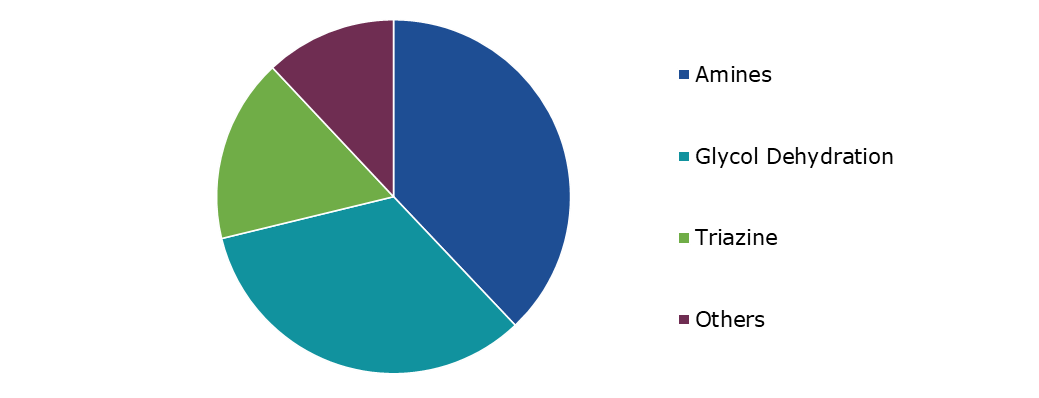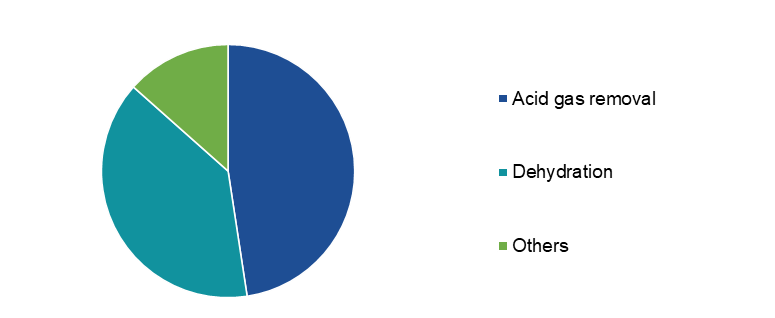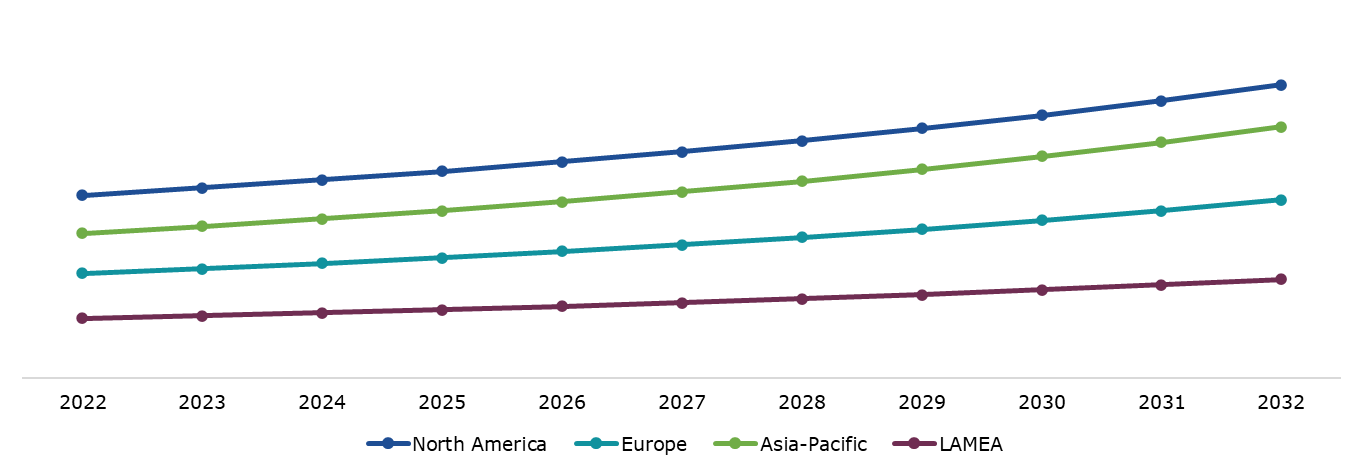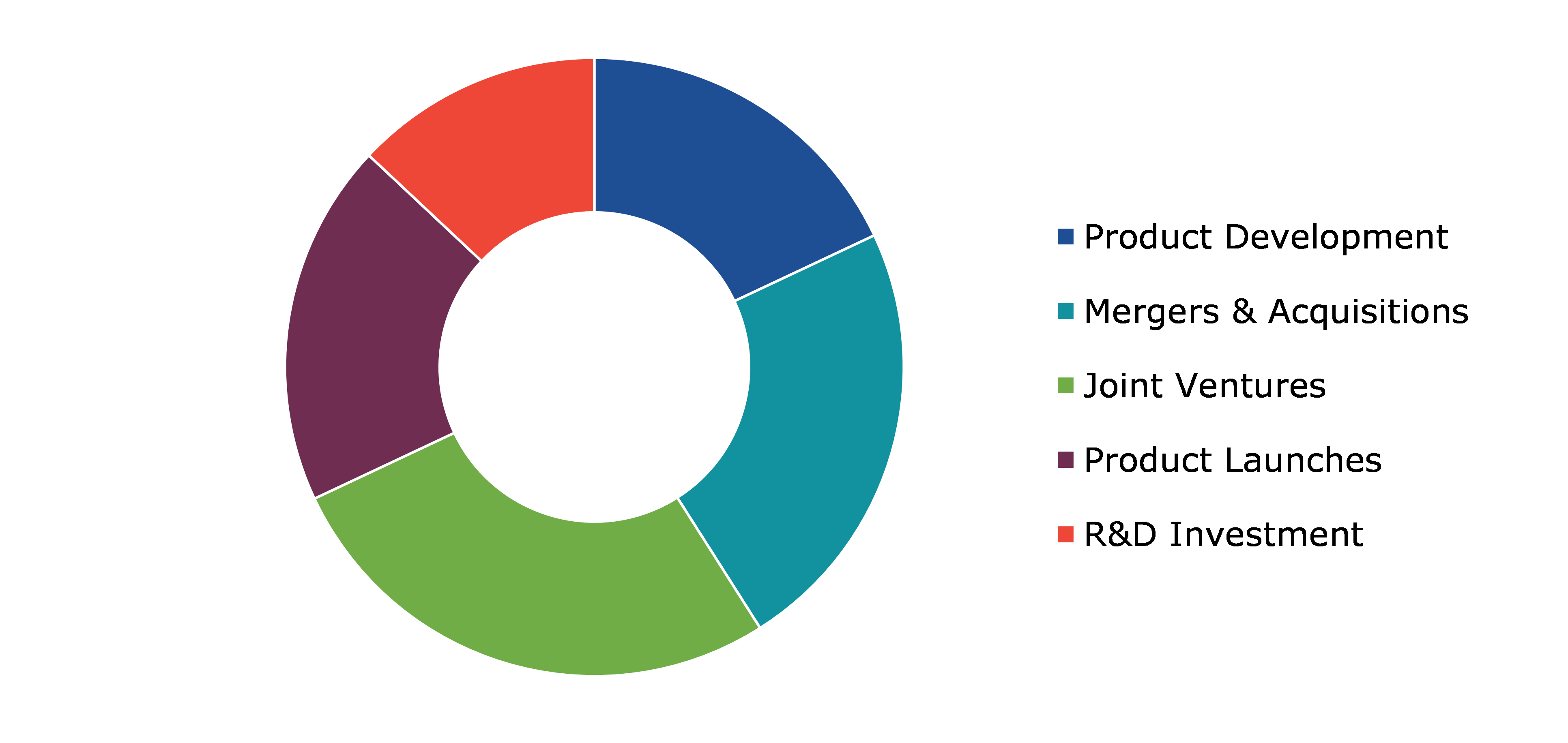Gas Treatment Market Report
RA07386
Gas Treatment Market, by Type (Amines, Non-amines), Application (Acid Gas Removal, Dehydration): Global Opportunity Analysis and Industry Forecast, 2020-2027
Gas Treatment Overview
Gas treatment referred to as gas conditioning, is a crucial process that enhances gas quality by eliminating undesirable components. This method's primary application is the absorption of corrosive gases from the atmosphere, such as hydrogen sulfide and carbon dioxide, using amine solutions. As gas treatment eliminates unwanted gases, it is crucial in processing natural gas and refining crude oil. Gas treatment ensures that the resulting gas stream complies with quality standards and environmental regulations by efficiently capturing and removing harmful gases using amine solutions. This procedure is essential in protecting infrastructure and equipment from corrosion and enhancing natural gas's overall efficiency. Gas treatment is a major and essential step in the energy industry, contributing to the production of cleaner and safer gas products for various applications.
Global Gas Treatment Market Analysis
The global gas treatment market size was $4,139.9 million in 2022 and is predicted to grow with a CAGR of 5.3%, by generating a revenue of $6,929.1 million by 2032.
Source: Research Dive Analysis
COVID-19 Impact on the Global Gas Treatment Market
The COVID-19 pandemic significantly impacted the gas treatment industry, introducing both challenges and opportunities. Lockdowns and restrictions led to a decrease in industrial activities and energy demand, causing a temporary reduction in gas treatment processes. There was a significant drop in emissions from many sources as several enterprises either closed or operated at reduced capacity. But the pandemic also made clear how crucial robust and environmentally friendly gas treatment options are. Improving air quality and emissions management systems is becoming more important as sectors work to recover and become resilient against challenges in the future. In order to comply with strict environmental regulations, there is an increasing demand for sophisticated gas treatment technology, such as effective scrubbers and catalytic converters. Remote monitoring and control systems are now necessary to maintain operational continuity during outages since the pandemic has also expedited digital transformation in the gas treatment industry.
The gas treatment sector has been greatly affected by the post-pandemic environment. The demand for energy has increased due to the global recovery, which has led to a rise in gas production. Although, the sector encounters obstacles such as disturbances in the supply chain and modifications in the tendencies of energy usage. Businesses are adjusting to the new standards by putting a focus on remote work and sustainability. Prioritizing enhanced safety measures has an impact on on-site procedures.
Rising Demand for Natural Gas to Drive the Market Growth
The increasing demand for natural gas has led to a rise in growth in the need for efficient gas treatment procedures. Natural gas is becoming a key component in the shift from conventional fossil fuels as civilizations throughout the world continue to emphasize greener energy sources. Due to its reduced carbon footprint as compared to coal and oil, it is a more environmentally responsible choice, due to which its demand has increased. The demand for comprehensive gas treatment grows as more homes and businesses rely on natural gas for their energy needs. To make natural gas suitable for consumption and transportation, it must first be purified and checked to fulfill strict quality standards. Pollutants, contaminants, and unwanted byproducts must be eliminated in order to maintain the integrity and efficacy of the natural gas supply. The growing demand for natural gas is driving growth and importance for companies that specialize in gas treatment technologies. The entire effectiveness and dependability of the natural gas infrastructure, in addition to environmental concerns, depend heavily on developments in gas treatment technology. The growing demand for natural gas is driving innovation and investment in gas treatment technology, creating a dynamic industry environment that aspires to meet evolving needs of a cleaner and more sustainable future. The use of gas treatment to enable the use of natural gas as a cleaner energy source is expected to become more important as the world's energy landscape continues to undergo revolutionary changes.
Fluctuating Raw Material Prices to Restrain the Market Growth
The dual problems of low supply and surging raw material costs lead to a serious challenge to the gas treatment sector. The industry's capacity to fulfill rising demand is being threatened by the shortage of vital raw materials required for gas treatment operations. Environmental restrictions that limit the extraction or use of specific commodities, supply chain disruptions, and geopolitical unpredictability all frequently make this scarcity worse. Further taxing gas treatment companies' would hamper the operating margins and thus lead to an increase in the cost of raw materials, which increases their financial burden. Any interruption in the supply chain can have a domino effect, lowering the overall productivity and efficiency of gas treatment facilities as the industry mostly depends on specialized parts and chemicals for efficient gas purification. The rising expenses of raw materials threaten not just the long-term objective of attaining affordable and sustainable environmental solutions, but also the economic feasibility of gas treatment projects.
Digital Transformation in Gas Treatment to Drive Excellent Opportunities
The energy business has a significant opportunity to improve efficiency, sustainability, and overall operational performance through the digital revolution of gas treatment. The management and optimization of business operations can be completely transformed by incorporating cutting-edge digital technology, such as machine learning, data analytics, and Internet of Things sensors, into gas treatment procedures. Real-time monitoring of gas treatment facilities is made possible by these developments, which provide proactive maintenance and the early detection of possible problems. Automation and the use of smart sensors also simplify procedures, lowering the need for manual intervention and the possibility of human error. This raises safety standards and increases the overall cost-effectiveness of gas treatment processes. Furthermore, digital transformation offers the potential for predictive modeling and advanced analytics, enabling companies to predict gas treatment requirements with greater accuracy. This insight enhances resource planning and allocation, optimizing the use of energy and minimizing waste.
Global Gas Treatment Market Share, by Type, 2022
Source: Research Dive Analysis
The amines sub-segment accounted for the highest market share in 2022. Amine is anticipated to establish a commanding market share in the gas treatment sector, signifying a considerable change in the industrial gas purification environment. The reason for amines' supremacy in this field is their exceptional ability to extract contaminants from different gas streams, including carbon dioxide and hydrogen sulfide. These adaptable substances have a strong affinity for acidic gases and produce easily separated, stable chemical complexes that make gas cleaning procedures more effective. As a result of their widespread use, they are better able to contribute to environmental sustainability by reducing the amount of hazardous chemicals released into the atmosphere. Amidates’ adoption increased as industries place a greater emphasis on environmentally friendly practices and strict emission restrictions take effect internationally since they are reliable and affordable solutions for meeting regulatory requirements. Furthermore, amines are essential parts of gas treatment methods because of their versatility in accommodating a wide range of applications in industries like petrochemicals, chemical processing, and oil & gas. As amines can be used in a variety of industrial contexts and work optimally under a range of gas compositions and operating conditions, they are in high demand.
Global Gas Treatment Market Share, by Application, 2022
Source: Research Dive Analysis
The acid gas removal sub-segment accounted for the highest market share in 2022. The segment dominance can be attributed to the vital function it plays in meeting legislation concerning environmental issues and gas emissions. Since industries strive to fulfill higher emission laws and lower their carbon footprint, there has been a considerable growth in the need for efficient methods for eliminating acid gases from the manufacturing unit. The significance of the application is demonstrated by its ability to lower the emission of harmful pollutants like sulfur dioxide and hydrogen sulfide, guarantee compliance with environmental regulations, and enhance overall operational efficiency. Since corporate social responsibility and sustainable practices are becoming more important, advanced technology for eliminating acid gas has also been used more frequently.
Global Gas Treatment Market Size & Forecast, by Region, 2022-2032 ($Million)
Source: Research Dive Analysis
The North America gas treatment market generated the highest revenue in 2022. The region’s significance can be ascribed to the abundance of natural gas resources available, especially in the U.S. and Canada, which have stimulated a boom in gas production and exploration efforts. To guarantee that pollutants and impurities are eliminated from extracted gases, there is a rising demand for efficient gas treatment systems. The demand for cutting-edge gas treatment solutions in the region is further driven by strict environmental restrictions and a growing emphasis on sustainable practices. North America is positioned as a major market for gas treatment solutions due to the region's developed energy infrastructure and strong industrial base. Furthermore, the growing use of nontraditional gas sources, including shale gas, has increased the need for specialist gas treatment procedures designed to handle the difficulties these resources present. With novel technologies and solutions taking center stage to satisfy the changing needs of the industry, the gas treatment market is positioned to observe sustained growth as long as North America maintains its leadership position in the global energy environment. The U.S. holds a strategic advantage in the gas treatment industry due to its dominance, which helps shape market trends and propel technological breakthroughs that support environmental sustainability and regulatory compliance.
Competitive Scenario in the Global Gas Treatment Market
Product launch, investment, and acquisition are common strategies followed by major market players. For instance, in May 2023, Linde, Heidelberg Materials, and BASF collaborated to establish a CO2 capture process, leveraging BASF's advanced OASE blue technology. This solution is expected to be implemented at the world's inaugural large-scale carbon capture and utilization (CCU) facility, operated by Capture-to-Use (CAP2U), a joint venture between Heidelberg Materials and Linde. Set to capture, purify, and liquefy approximately 70,000 tons of CO₂ annually, this facility marks a significant milestone in the seek for sustainable industrial practices. The captured liquid CO₂ would be primarily sold by Linde, serving as a crucial feedstock for the chemicals industry while also catering to the food & beverage market. The unique property of the project is the incorporation of the patented OASE aerozone design, a technology known for mitigating dust and aerosol-induced emissions in gas flows. In this venture, the aerozone design takes on one of its initial industrial applications, highlighting the commitment toward environmental responsibility and reducing the ecological footprint of industrial processes. This cooperative endeavor provides a cutting-edge technology that simultaneously promotes industrial efficiency and environmental sustainability, in addition to addressing the critical demand for carbon capture. As the world moves toward a more sustainable and environmentally friendly industrial landscape, the successful execution of this program is expected to serve as a model for future carbon capture and utilization projects, demonstrating the practicality and scalability of these kinds of solutions.
Source: Research Dive Analysis
Some of the leading gas treatment market players are Amines & Plasticizers Ltd, Ecolab Inc, Huntsman International LLC, BASF SE, SAMSON CONTROLS INC, Eunisell Chemicals, DowDuPont Inc., Akzo Nobel N.V., Clariant, and Berryman Chemicals Inc.
| Aspect | Particulars |
| Historical Market Estimations | 2020-2021 |
| Base Year for Market Estimation | 2022 |
| Forecast Timeline for Market Projection | 2023-2032 |
| Geographical Scope | North America, Europe, Asia-Pacific, and LAMEA |
| Segmentation by Type |
|
| Segmentation by Application |
|
| Key Companies Profiled |
|
Q1. What is the size of the global gas treatment market?
A. The size of the global gas treatment market was $4,139.9 million in 2022 and is projected to reach $6,929.1 million by 2032.
Q2. Which are the major companies in the gas treatment market?
A. Amines & Plasticizers Ltd, Ecolab Inc, Huntsman International LLC, BASF SE, SAMSON CONTROLS INC, Eunisell Chemicals, DowDuPont Inc., Akzo Nobel N.V., Clariant, and Berryman Chemicals Inc. are some of the key players in the global gas treatment market.
Q3. Which region, among others, possesses greater investment opportunities in the future?
A. Asia-Pacific possesses great investment opportunities for investors in the future.
Q4. What will be the growth rate of the Asia-Pacific gas treatment market?
A. The Asia-Pacific gas treatment market is anticipated to grow at 5.7% CAGR during the forecast period.
Q5. What are the strategies opted by the leading players in this market?
A. Continuous improvement and brand product differentiation are the two key strategies opted by the operating companies in this market.
Q6. Which companies are investing more on R&D practices?
A. Huntsman International LLC and BASF SE are the companies investing more on R&D activities for developing new products and technologies.
1. Research Methodology
1.1. Desk Research
1.2. Real time insights and validation
1.3. Forecast model
1.4. Assumptions and forecast parameters
1.5. Market size estimation
1.5.1. Top-down approach
1.5.2. Bottom-up approach
2. Report Scope
2.1. Market definition
2.2. Key objectives of the study
2.3. Market segmentation
3. Executive Summary
4. Market Overview
4.1. Introduction
4.2. Growth impact forces
4.2.1. Drivers
4.2.2. Restraints
4.2.3. Opportunities
4.3. Market value chain analysis
4.3.1. List of raw material suppliers
4.3.2. List of manufacturers
4.3.3. List of distributors
4.4. Innovation & sustainability matrices
4.4.1. Technology matrix
4.4.2. Regulatory matrix
4.5. Porter’s five forces analysis
4.5.1. Bargaining power of suppliers
4.5.2. Bargaining power of consumers
4.5.3. Threat of substitutes
4.5.4. Threat of new entrants
4.5.5. Competitive Rivalry Intensity
4.6. PESTLE analysis
4.6.1. Political
4.6.2. Economical
4.6.3. Social
4.6.4. Technological
4.6.5. Legal
4.6.6. Environmental
4.7. Impact of COVID-19 on gas treatment market
4.7.1. Pre-covid market scenario
4.7.2. Post-covid market scenario
5. Gas Treatment Market Analysis, by Type
5.1. Overview
5.2. Amines
5.2.1. Definition, key trends, growth factors, and opportunities
5.2.2. Market size analysis, by region, 2022-2032
5.2.3. Market share analysis, by country, 2022-2032
5.3. Glycol Dehydration
5.3.1. Definition, key trends, growth factors, and opportunities
5.3.2. Market size analysis, by region, 2022-2032
5.3.3. Market share analysis, by country, 2022-2032
5.4. Triazine
5.4.1. Definition, key trends, growth factors, and opportunities
5.4.2. Market size analysis, by region, 2022-2032
5.4.3. Market share analysis, by country, 2022-2032
5.5. Others
5.5.1. Definition, key trends, growth factors, and opportunities
5.5.2. Market size analysis, by region, 2022-2032
5.5.3. Market share analysis, by country, 2022-2032
5.6. Research Dive Exclusive Insights
5.6.1. Market attractiveness
5.6.2. Competition heatmap
6. Gas Treatment Market Analysis, by Application
6.1. Overview
6.2. Acid Gas Removal
6.2.1. Definition, key trends, growth factors, and opportunities
6.2.2. Market size analysis, by region, 2022-2032
6.2.3. Market share analysis, by country, 2022-2032
6.3. Dehydration
6.3.1. Definition, key trends, growth factors, and opportunities
6.3.2. Market size analysis, by region, 2022-2032
6.3.3. Market share analysis, by country, 2022-2032
6.4. Others
6.4.1. Definition, key trends, growth factors, and opportunities
6.4.2. Market size analysis, by region, 2022-2032
6.4.3. Market share analysis, by country, 2022-2032
6.5. Research Dive Exclusive Insights
6.5.1. Market attractiveness
6.5.2. Competition heatmap
7. Gas Treatment Market, by Region
7.1. North America
7.1.1. U.S.
7.1.1.1. Market size analysis, by Type, 2022-2032
7.1.1.2. Market size analysis, by Application, 2022-2032
7.1.2. Canada
7.1.2.1. Market size analysis, by Type, 2022-2032
7.1.2.2. Market size analysis, by Application, 2022-2032
7.1.3. Mexico
7.1.3.1. Market size analysis, by Type, 2022-2032
7.1.3.2. Market size analysis, by Application, 2022-2032
7.1.4. Research Dive Exclusive Insights
7.1.4.1. Market attractiveness
7.1.4.2. Competition heatmap
7.2. Europe
7.2.1. Germany
7.2.1.1. Market size analysis, by Type, 2022-2032
7.2.1.2. Market size analysis, by Application, 2022-2032
7.2.2. UK
7.2.2.1. Market size analysis, by Type, 2022-2032
7.2.2.2. Market size analysis, by Application, 2022-2032
7.2.3. France
7.2.3.1. Market size analysis, by Type, 2022-2032
7.2.3.2. Market size analysis, by Application, 2022-2032
7.2.4. Spain
7.2.4.1. Market size analysis, by Type, 2022-2032
7.2.4.2. Market size analysis, by Application, 2022-2032
7.2.5. Italy
7.2.5.1. Market size analysis, by Type, 2022-2032
7.2.5.2. Market size analysis, by Application, 2022-2032
7.2.6. Rest of Europe
7.2.6.1. Market size analysis, by material, 2022-2032
7.2.6.2. Market size analysis, by Application, 2022-2032
7.2.7. Research Dive Exclusive Insights
7.2.7.1. Market attractiveness
7.2.7.2. Competition heatmap
7.3. Asia-Pacific
7.3.1. China
7.3.1.1. Market size analysis, by Type, 2022-2032
7.3.1.2. Market size analysis, by Application, 2022-2032
7.3.2. Japan
7.3.2.1. Market size analysis, by Type, 2022-2032
7.3.2.2. Market size analysis, by Application, 2022-2032
7.3.3. India
7.3.3.1. Market size analysis, by Type, 2022-2032
7.3.3.2. Market size analysis, by Application, 2022-2032
7.3.4. Australia
7.3.4.1. Market size analysis, by Type, 2022-2032
7.3.4.2. Market size analysis, by Application, 2022-2032
7.3.5. South Korea
7.3.5.1. Market size analysis, by Type, 2022-2032
7.3.5.2. Market size analysis, by Application, 2022-2032
7.3.6. Rest of Asia-Pacific
7.3.6.1. Market size analysis, by Type, 2022-2032
7.3.6.2. Market size analysis, by Application, 2022-2032
7.3.7. Research Dive Exclusive Insights
7.3.7.1. Market attractiveness
7.3.7.2. Competition heatmap
7.4. LAMEA
7.4.1. Brazil
7.4.1.1. Market size analysis, by Type, 2022-2032
7.4.1.2. Market size analysis, by Application, 2022-2032
7.4.2. Saudi Arabia
7.4.2.1. Market size analysis, by Type, 2022-2032
7.4.2.2. Market size analysis, by Application, 2022-2032
7.4.3. Saudi Arabia
7.4.3.1. Market size analysis, by Type, 2022-2032
7.4.3.2. Market size analysis, by Application, 2022-2032
7.4.4. South Africa
7.4.4.1. Market size analysis, by Type, 2022-2032
7.4.4.2. Market size analysis, by Application, 2022-2032
7.4.5. Rest of LAMEA
7.4.5.1. Market size analysis, by Type, 2022-2032
7.4.5.2. Market size analysis, by Application, 2022-2032
7.4.6. Research Dive Exclusive Insights
7.4.6.1. Market attractiveness
7.4.6.2. Competition heatmap
8. Competitive Landscape
8.1. Top winning strategies, 2022
8.1.1. By strategy
8.1.2. By year
8.2. Strategic overview
8.3. Market share analysis, 2022
9. Company Profiles
9.1. Amines & Plasticizers Ltd.
9.1.1. Overview
9.1.2. Business segments
9.1.3. Product portfolio
9.1.4. Financial performance
9.1.5. Recent developments
9.1.6. SWOT analysis
9.2. Ecolab Inc.
9.2.1. Overview
9.2.2. Business segments
9.2.3. Product portfolio
9.2.4. Financial performance
9.2.5. Recent developments
9.2.6. SWOT analysis
9.3. Huntsman International LLC
9.3.1. Overview
9.3.2. Business segments
9.3.3. Product portfolio
9.3.4. Financial performance
9.3.5. Recent developments
9.3.6. SWOT analysis
9.4. BASF SE
9.4.1. Overview
9.4.2. Business segments
9.4.3. Product portfolio
9.4.4. Financial performance
9.4.5. Recent developments
9.4.6. SWOT analysis
9.5. SAMSON CONTROLS INC.
9.5.1. Overview
9.5.2. Business segments
9.5.3. Product portfolio
9.5.4. Financial performance
9.5.5. Recent developments
9.5.6. SWOT analysis
9.6. Eunisell Chemicals
9.6.1. Overview
9.6.2. Business segments
9.6.3. Product portfolio
9.6.4. Financial performance
9.6.5. Recent developments
9.6.6. SWOT analysis
9.7. DowDuPont Inc.
9.7.1. Overview
9.7.2. Business segments
9.7.3. Product portfolio
9.7.4. Financial performance
9.7.5. Recent developments
9.7.6. SWOT analysis
9.8. Akzo Nobel N.V.
9.8.1. Overview
9.8.2. Business segments
9.8.3. Product portfolio
9.8.4. Financial performance
9.8.5. Recent developments
9.8.6. SWOT analysis
9.9. Clariant
9.9.1. Overview
9.9.2. Business segments
9.9.3. Product portfolio
9.9.4. Financial performance
9.9.5. Recent developments
9.9.6. SWOT analysis
9.10. Berryman Chemicals Inc.
9.10.1. Overview
9.10.2. Business segments
9.10.3. Product portfolio
9.10.4. Financial performance
9.10.5. Recent developments
9.10.6. SWOT analysis
Personalize this research
- Triangulate with your own data
- Request your format and definition
- Get a deeper dive on a specific application, geography, customer or competitor
- + 1-888-961-4454 Toll - Free
- support@researchdive.com






